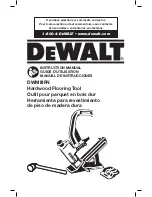
6- ENG
Lubrication
Frequent, but not excessive, lubrication is required for best performance. Use Air Tool
Lubricant, Mobil Velocite #10, or equivalent. Do not use detergent oil or additives as
these lubricants will cause accelerated wear to the seals and bumpers in the tool,
resulting in poor tool performance and frequent tool maintenance. Only a few drops
of oil at a time is necessary. Too much oil will only collect inside the tool and will be
noticeable in the exhaust cycle.
COLD WEATHER OPERATION:
For cold weather operation, near and below freezing, the moisture in the air line may
freeze and prevent tool operation. We recommend the use of winter formula air tool
lubricant or permanent antifreeze (ethylene glycol) as a cold weather lubricant.
NOTICE:
Do not store tools in a cold weather environment to prevent frost or ice
formation on the tools operating valves and mechanisms that could cause tool failure.
NOTICE: Some commercial air line drying liquids are harmful to “O”-rings
and seals – do not use these low temperature air dryers without checking
compatibility.
Loading The DWMIIIFN
WARNING:
EYE PROTECTION which conforms to ANSI specifications
and provides protection against flying particles both from the FRONT and
SIDE should ALWAYS be worn by the operator and others in the work area
when connecting to air supply, loading, operating or servicing this tool. Eye
protection is required to guard against flying fasteners and debris, which
could cause severe eye injury.
The employer and/or user must ensure that proper eye protection is
worn. Eye protection equipment must conform to the requirements of the
American National Standards Institute, ANSI CAN/CSA Z89.1 and provide
both frontal and side protection.
Non-side shielded spectacles and face
shields alone do not provide adequate protection.
WARNING: TO PREVENT ACCIDENTAL INJURIES:
• Never place a hand or any other part of the body in nail discharge area
of tool while the air supply is connected.
• Never point the tool at anyone else.
• Never engage in horseplay.
• Never actuate the tool unless nose is directed at the work.
• Always handle the tool with care.
• Do not actuate the tool while loading.
CLEAT LOADING
Insert cleats. Pull pusher assembly back to engage pusher to strip of cleats. Tool is
now ready to operate.
NOTE:
Use only cleats recommended for use in the DWMIIIFN nailer or nails which
meet the D
e
WALT Cleat specifications.




























